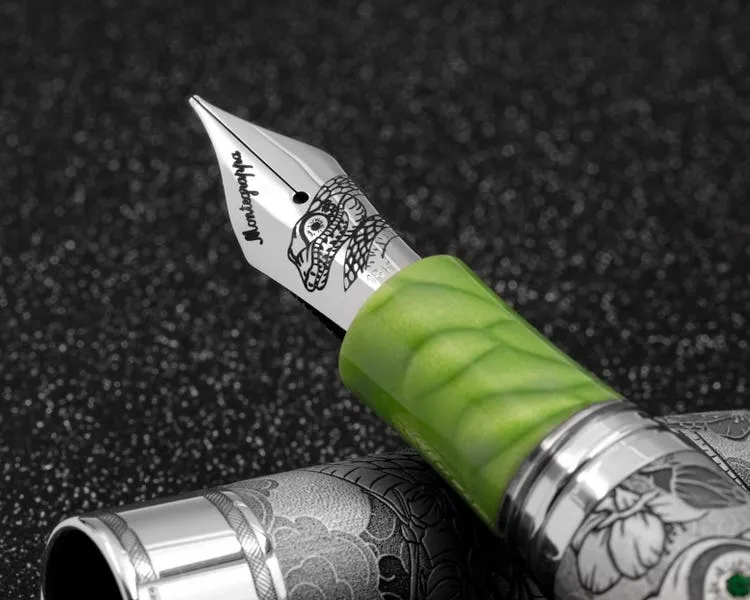Forbes contributors publish independent expert analyses and insights.
In an era where fingertips skim glass screens and keyboards clatter in relentless rhythm, the act of putting pen to paper feels almost radical. Handwriting, once so ordinary it scarcely merited thought, is now framed as an act of intention. To write by hand is to slow the pace, to weigh words more carefully, to leave a mark not just of language but of self. It is in this delicate, deeply human space that Montegrappa, Italy's oldest manufacturer of fine writing instruments, has built its reputation for more than a century.
For Giuseppe Aquila, the company's chief executive and the latest custodian of his family's legacy, handwriting is not simply a vestige of the past. It is a craft, a language, and a bridge between eras. "At Montegrappa, we have always believed that handwriting is much more than a utilitarian act -- it's an expression of identity, emotion, and heritage," he says. "In an increasingly digital world, the act of writing by hand has become a powerful symbol of authenticity and intention."
This philosophy is not romantic indulgence but rooted in both science and society. Neuroscience demonstrates that writing by hand activates areas of the brain responsible for memory and creativity in ways typing cannot. As Aquila puts it: "Handwriting is a deeply human act. Neuroscience tells us that writing by hand activates memory, creativity, and emotional processing in ways that typing never can. A well-crafted pen invites you to write more, to enjoy the weight of words, and to rediscover the beauty of self-expression."
Montegrappa's role is not simply to manufacture pens but to preserve handwriting as a contemporary art form. In the company's Venetian workshops, artisans with decades of expertise engrave, enamel, and sculpt writing instruments that are both functional and inspirational. "I often say that writing is thinking made visible," Aquila reflects. "In an era of instant messages and emojis, a handwritten note feels rare and intimate; it carries a piece of you in every stroke."
This insistence on the human hand has shaped Montegrappa's most celebrated collections, none more enduring than its "Year Of" series. First conceived in the 1990s, the collection draws inspiration from Aquila's travels in the Far East. "There was something endlessly captivating about the elegance of its traditions, the depth of its artistry, and the quiet poetry in its way of life," he recalls. "In many parts of Asia, the Chinese zodiac is more than folklore; it is a guide, a source of wisdom, and often a topic of animated conversation. Those encounters left a mark on me."
From this fascination grew the first zodiac-inspired pens, created as tributes to cultural richness and symbolism. The "Year Of" series remains a cornerstone of Montegrappa's identity, each edition taking a fresh direction, rooted in the mythology and character of that year's animal.
"Each Montegrappa pen tells a story, with the Year Of editions drawing on the symbolism of zodiac animals," Aquila explains. The Imperial Year of the Dragon pen, for example, reflects luck and power through a sterling silver design, while its Regal counterpart uses Juma material to mimic dragon scales. The Year of the Snake coils in a flowing form, embodying wisdom and transformation.
These details are not decorative flourishes; they are narratives in miniature, connecting the craftsmanship of Veneto to the storytelling traditions of the East. "Storytelling is in our DNA," Aquila says. "Since 1912, we've believed that a pen is more than a writing tool - it's a vessel for meaning and emotion. With the Year Of series, the constant is the zodiac; but each edition takes a new direction rooted in the mythology of that year's animal."
The pens are as much heirlooms as they are writing instruments. Collectors prize those with complex enamelling or high-relief engraving not just for their artistry but for their resonance. "Unsurprisingly, the dragons always lead the way," Aquila says. "The dragon is considered the most auspicious of all zodiac signs, and its appeal goes far beyond Asia. Collectors worldwide are drawn to it."
Here, symbolism translates directly into demand. A pen becomes both a luxury object and a cultural artefact—a bridge between myth and modernity.
The appeal extends far beyond collectors' cabinets. These pens often become deeply symbolic gifts, chosen to mark life milestones or to cement partnerships. "These pens often become more than gifts; they're meaningful tokens of connection and good fortune," Aquila reflects. He recalls a Year of the Dragon pen being presented during a high-level diplomatic meeting. "It wasn't just a beautiful object; it carried a wish for prosperity and harmony between the parties. That's the magic of these pens: they communicate sentiment and tradition in a way few gifts can."
For Aquila, the act of writing by hand is inseparable from the stories his pens carry. The "Year Of" series demonstrates that craft can embody cultural traditions, but it is handwriting itself that gives those traditions life. "Our artisans talk about handwriting as a bridge between the mind and the heart—a way of leaving a part of yourself for someone else to hold onto," he says.
In this way, Montegrappa's pens are not only luxury objects but guardians of human connection. They remind us that, in a world of fleeting messages, the written word has the power to endure.
As the digital tide rises, Montegrappa is charting its own course. With the "Year Of" series, the company demonstrates how craftsmanship can sustain and reinterpret cultural traditions, carrying them forward through objects that invite both reflection and use. Each pen is not simply a tool but a story waiting to be written; proof that in the right hands handwriting remains one of the most powerful forms of human connection.
